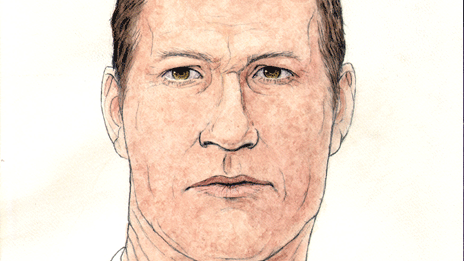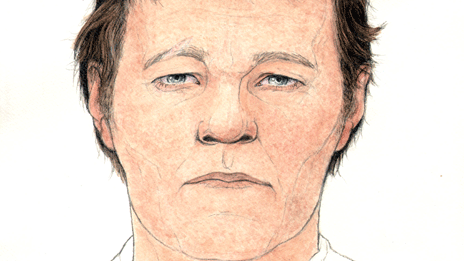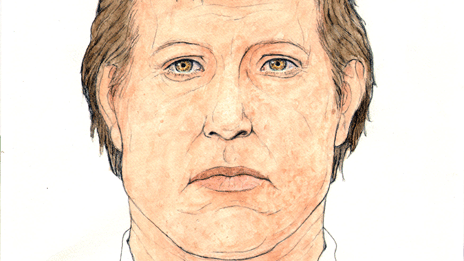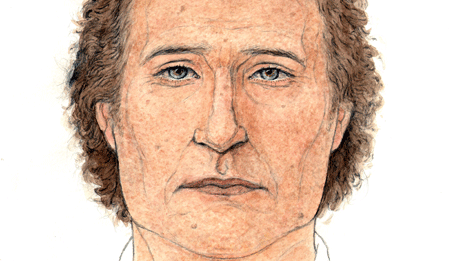More than 30 years after it was raised from the seabed - and almost 500 years since it sank - the secrets of Henry VIII's flagship, the Mary Rose, are being revealed to the public - along with the faces of its crew.
Just yards from where it was first constructed from 600 oak trees near Portsmouth's naval docks in 1510, the wreck of the Tudor warship now stands on view in its new £35m home.
Where once stood a proud, cutting-edge ship built for war, now lies a reconstructed array of wooden decks and pillars, withered by their hundreds of years at the bottom of the Solent.
Standing nearby are some of the men who shared a grave with the ship for hundreds of years, their faces now reconstructed and displayed for the first time.
Viewed through windows on three separate floors, the preserved wreck stands opposite some of its 19,000 artefacts recovered from the depths.
Continue reading the main story The Mary Rose carried both new modern bronze cannons and old medieval wrought iron ones
The Mary Rose carried both new modern bronze cannons and old medieval wrought iron ones
 A backgammon set and dice shaker and two dice found in the carpenter's cabin
A backgammon set and dice shaker and two dice found in the carpenter's cabin
 Few pieces of textiles have survived but shoes and boots making up about 415 pairs have been discovered
Few pieces of textiles have survived but shoes and boots making up about 415 pairs have been discovered
 The masts, debris and bodies from the sinking Mary Rose can be seen just above Southsea castle on this image depicting the Battle of the Solent
The masts, debris and bodies from the sinking Mary Rose can be seen just above Southsea castle on this image depicting the Battle of the Solent
 When archaeologists opened some of the jars they could still smell what they had contained, for example menthol
When archaeologists opened some of the jars they could still smell what they had contained, for example menthol
Within the exhibition the recreated decks, dimly lit interiors and groaning sounds of the sea outside all combine to give the sense of being on board the 16th Century vessel.
The crew's quarters are all visible, while rows of cannons line the main deck, pointing out of the open gunports ready to be fired at enemy ships.
It is a Tudor time capsule - dubbed "Britain's Pompeii" by historian David Starkey - and its custodians cannot wait to show it off.
The story of the Mary Rose

1510 - The ship is ordered by the newly crowned King Henry VIII and construction begins in Portsmouth. It is launched in 1511.
1512 - The king's flagship fights its first battle, leading an attack on a French fleet. The ship's captain called it "The noblest ship of sail".
1545 - On 19 July, at the Battle of the Solent, the ship sinks while leading the attack on the French invasion fleet.
1545-1549 - Expert Venetian salvors make unsuccessful attempts to raise the wreck. They do recover sails, parts of the masts and the rigging, and later some guns.
1549-1836 - The ship lies undisturbed for almost 300 years.
1836 - Early pioneering divers, John and Charles Deane, discover the wreck site and raise guns using explosives. They later lose its location.
1965 - A new search for the wreck begins.
1971 - Divers see the first exposed timbers and the site is identified as the Mary Rose.
1979-1982 - The ship's contents are excavated by divers and more than 19,000 artefacts are brought to the surface.
1982 - The wreck of the hull is raised. The event is watched live on television by an estimated 60 million people worldwide.
Source: Mary Rose Trust
"What we're aiming to achieve here is a mirror image of the ship and to show artefacts where they belonged," explains Nick Butterley, exhibition co-ordinator.
"So many things in this gallery you can immediately look at and understand what they are. That's one of the real beauties of the collection, how realistic and normal it feels."
Every artefact on show here is an original piece found with the wreck. Some of the cannons were still sticking out of the gunports when it was discovered in 1971.
The Mary Rose was raised from the seabed of the Solent in 1982, and has been on display before, but it is only now that insights into life on board are being shown to the public.
Forensic scientists, more used to working with murder victims, have recreated the faces of seven of the about 500 men who died when the ship sank in 1545.
The new Mary Rose Museum has been dedicated to them, and it is through them the story of the ship is now being told.
Curators had no list of crew names, just numbers. Only the names of the vice admiral, Sir George Carew, and the master, Roger Grenville, are known.
Maritime archaeologist Alex Hildred was part of the team who excavated and raised the wreck and has since studied the human remains to discover more about the men and boys - whose ages range from 12 to 40 - found on board.
"You've got a really good glimpse of Tudor males at a moment in time," she says. "It's a healthy, living population, you are not looking at a churchyard.
"They were pretty well fed once they were on the ship - we know that from the diet. But there had been severe famines in the 1520s, so some of their bones have got evidence of vitamin deficiency, such as rickets or sometimes scurvy from the fact that they suffered as children.
"They've also got a lot of healed fractures - which is what you'd expect on a warship - a number of broken noses, one arrow wound and some arthritis. These guys were used to lifting heavy things."
The human remains found are displayed in galleries at the bow and stern of the ship, along with thousands of artefacts.
"This is where we personalise the collection, trying to show that these objects belonged to real people who lived and sadly died on the ship," explains maritime archaeologist Christopher Dobbs, giving the BBC a guided tour.
Forensic artist Oscar Nilsson explains to Robert Hall how he created a model of one of the sailors who drowned on the Mary Rose
"One thing that's so powerful about the Mary Rose collection is that we found a number of chests in the ship and they tell us about an individual person, because they contain the objects that belonged to a person."
He says the master carpenter's chest, for example, contained three plates, a tankard, a sundial, a book and even a backgammon set - indicating "quite a wealthy person".
"We also, just outside the carpenter's cabin, found the skeleton of a dog," he adds.
"It's these tiny insights that we've got into Tudor life, as well as the obvious things like guns and rigging, that really make our display so exceptional."
Trapped and drownedWhen the Mary Rose was built, it was part of a new generation of modern carvel-built ships - planks laid side to side - which featured gunports with lids, allowing heavier guns to be carried.
The warship fought its first battle in 1512 against France after King Henry VIII joined Pope Julius II's Holy League against the French the previous year. It fought many more over the next 34 years.
 The recovered wreck is on show behind glass walls opposite the artefacts
The recovered wreck is on show behind glass walls opposite the artefacts
But Mary Rose's life as a serving Navy ship came to an abrupt end on 19 July 1545, when it sank during the Battle of the Solent while, once again, leading the attack on the French invasion fleet.
Francis I was attempting an invasion of England with 30,000 soldiers and more than 220 ships - much larger than the more well-known Spanish Armada 43 years later.
“Start Quote
End Quote Christopher Dobbs Maritime archaeologistIt was like a time capsule within a time capsule, within a time capsule”
The English had about 60 ships and 12,000 soldiers, but managed to fight off the French who eventually retreated the day after the Mary Rose sank.
Only 35 men survived disaster, according to contemporary records. Many would have been trapped under the anti-boarding netting and drowned.
Legend has it that Henry VIII watched in horror from Southsea castle along with the wife of Vice Admiral Sir George Carew.
As the ship sank, the cries and screams from the drowning men and boys could be heard back on land. The loss of the ship is said to have affected the king deeply.
Accounts on what happened that day differ, but one survivor claimed the ship had just fired its guns on one side and was turning to fire from the other when the wind caught its sails and plunged the open gunports below the water, which sank it.
French historians claim its forces were responsible for sinking the Mary Rose in battle.
Sweden's Vasa ship

The only other maritime achievement comparable to the raising and restoration of the Mary Rose is that of the 17th Century Vasa warship in Stockholm in 1961.
The flagship of King Gustav Adolf, it sank on its maiden voyage in 1628 because it had been built top heavy and did not have enough ballast.
Like the Mary Rose, the Vasa lay undisturbed on the seabed for more than 300 years.
In 1956, divers Anders Franzén and Per Edvin Fälting relocated Vasa off Beckholmen. In 1961 it was raised, refloated and moved to a dry dock.
For 17 years the Vasa was sprayed with Polyethylene Glycol (PEG), the same type of wax scientists later used to preserve the Mary Rose.
But the Vasa looks much the same as it did the day it sank because shipworms do not thrive in the brackish water of the Baltic.
Source: Vasa Museum
For the next 300 years the Mary Rose - like a snapshot of Tudor military life - lay undisturbed on the seabed.
Even though many items from the wreck were raised by early pioneering divers John and Charles Deane in 1836, the site was then lost again for another 100 years.
It was finally located again in 1971 and, since then, divers have made 27,000 dives to the wreck site outside the entrance to Portsmouth Harbour.
One chest got archaeologists particularly excited when they discovered it had a secret compartment. Mr Dobbs says they thought it may contain something valuable the wealthy owner was trying to hide.
"It was like a time capsule within a time capsule, within a time capsule," explains Mr Dobbs. "But it only had a pin in it."
"Maybe this once was used to hold together some important papers that have not survived. We will never know."
But there are many more secrets the team is still hoping to reveal and the new museum is being heralded as a new beginning for the Mary Rose story.
Many of the items found have still not been identified, but as artefacts go on display the curators hope they are identified by experts in various fields who share their knowledge.
"We had the bishop of Portsmouth here last week and he saw this book cover and pointed out it was probably the ship's bible cover," Mr Dobbs adds.
"We are learning more as we go along."









